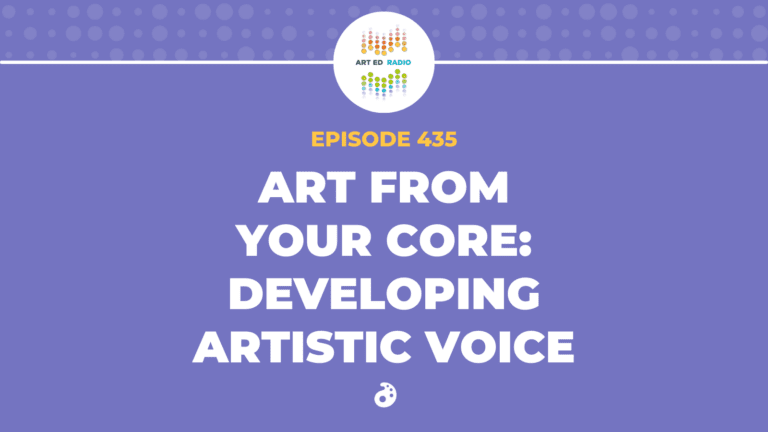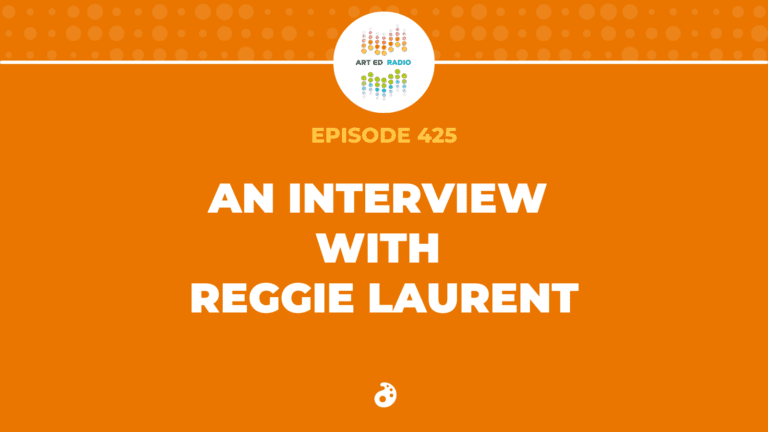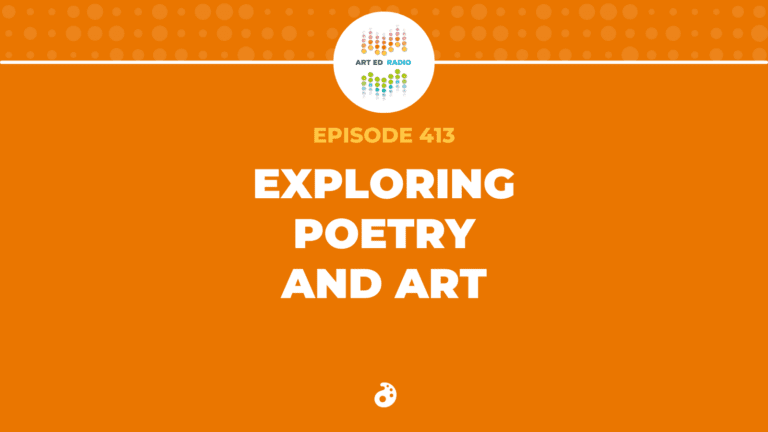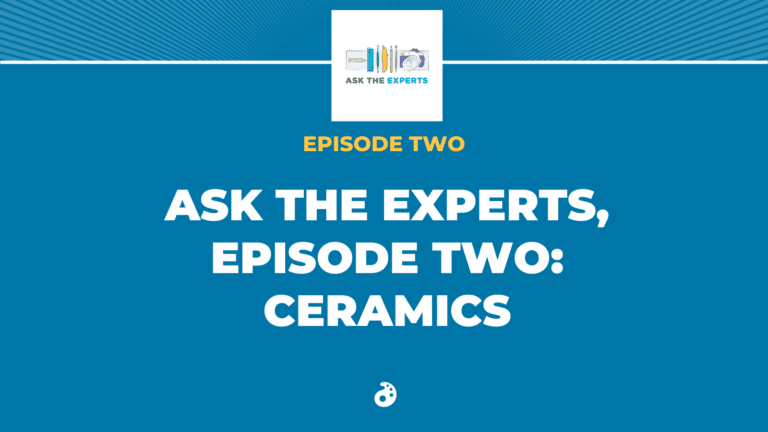Jen Leban is back on the show today to talk about her favorite creative challenges that can be found in Adobe Express and preview her upcoming NOW Conference presentation! Listen as she and Tim discuss making connections and creating challenges with tech, some of Jen’s favorite projects with drawing and animation, and opportunities for learning and creating for both teachers and students. Full episode transcript below.
Resources and Links
- Getting Creative with Tech
- Listen to one of Jen’s previous podcast appearances
- Find all you need to know about the NOW Conference
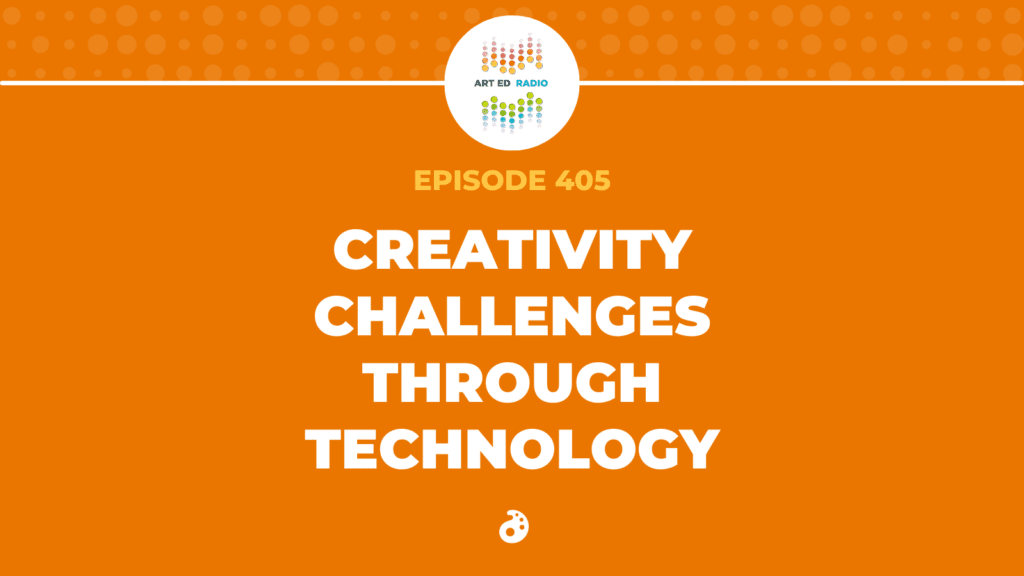
Transcript
Tim:
Welcome to Art Ed Radio, the podcast for art teachers. This show is produced by the Art of Education University, and I’m your host, Tim Bogatz.
We are now just two weeks away from the Winter NOW conference, and as I said last week, I want to take the opportunity here to use the podcast to preview some interesting presentations and to talk to some interesting presenters. Today’s guest is going to be Jen Leban. Now, I’ve known Jen for a while now, actually over a decade now that I think about it, but she is an awesome teacher. She’s presented at NOW many times. She had a ton of great ideas as an art teacher, and now that she’s in the world of tech, she does an incredible job of blending tech and art together in what she does with both students she works with and the teachers that she’s helping as well. So her presentation at the conference next Saturday is on how to bring creativity challenges to your students, specifically utilizing the Adobe Express platform.
So we’re going to talk today about some of our favorite tools on the platform and how teachers can get started using it. So Jenna’s here, she is ready to go, so let me bring her on. All right, Jen Lieben back on the podcast with me. Jen, how are you?
Jen:
I am good. Good morning. How are you doing?
Tim:
I am doing very well. I’ve been playing with Adobe Express ever since I watched the first draft of your presentation, so been distracted with that, but otherwise things are good. How was the semester for you? How was January so far?
Jen:
Well, it’s been super cold so we’ve had some e-learning days. We’ve had some e-learning days going on, but outside of that, this semester is going pretty well. I had a PD day where I got to present in person to teachers about Adobe Express, and now because a tech coach, I’ve gotten a lot of requests from teachers to actually use it in the classroom. So right before we recorded, I actually ran from another classroom and we were doing an Adobe Express project.
Tim:
That’s perfect. I love it. Well, and I think, yeah, like I said, as soon as I saw everything that you were doing, I was like, I need to try this out. So I’m hoping that people will kind of have that same reaction when they see you at Now. But, I guess, to start with, to start our conversation here, can you just tell everybody about your presentation, what you’re doing in that, what they can expect to see from you?
Jen:
So as a former art teacher, I love any tech and creativity kind of mashed together. That’s right up my alley. That’s kind of the thing that I’m known for in my network of coaches, like talk to Jen if you want Arty Tech stuff. So I love Adobe Express because obviously Adobe, the first thing you think of, it’s in that Adobe family. I like to think of Adobe Express as Adobe Junior. So it’s great for elementary, it’s great for middle school, especially if your school district is, not transitioning, but if your curriculum articulates and they’re using Adobe tools in the high school level, it’s great to get their feet wet because it’s that same family.
NOW that being said, Adobe Express looks and works a lot like Canva, which I know is another tool that teachers super love. So if you are a Canva fan, making the transition, or not even the transition, but getting into it, the user interface, the experience is very, very similar, so I think it’s easy. It’s not like, oh, I have to learn another tool. I think they’re very comparable. I use both, and the reason for that is there are some things Canva can do that Adobe can’t, and there’s some things that Adobe can do that Canva can’t, so it’s just about choosing the right tool for what you want to do. And I’ve lately really gotten into what are those things that Adobe can do that are really fun. So yeah, I like sharing it with people.
Tim:
Yeah, that’s awesome. That’s awesome. And I guess, like I said, I’ve started to explore, I’ve started to play around. I don’t know what I’m doing, but that’s okay because like you said, it’s really user-friendly. I have a little bit of experience with Adobe, so it makes sense. I have some experience with Canvas, so now that you say that, I was like, yes, I definitely see those connections but I guess I would just like advice for people. If people are exploring Adobe Express, where do you think is a good place to start? What are some things that you can do in the beginning to see what its potential is or see some of the things you can do with the platform?
Jen:
So my favorite introductory project, which I do with students, and I do when I’m presenting this to teachers, is, they call it a creativity challenge, and Adobe has a lot of these that you can, like pre-done lesson plans. So if you’re like, I need someone to do all this thinking for me, it’s there, so as a teacher, you can go in and you can literally download their lesson plans, it’s there, but as an art teacher, that never makes me happy, I always have to do it myself. As I said, I have to customize it and make it more pretty. But there’s a challenge called My Creative Identity, and it’s essentially you take a photo of yourself and it removes the background, which, again, something you can do in Canva, but you put yourself in the middle, and then there’s a bunch of elements that kind of come out from the middle. This is the template that they give you at least.
So my challenge to students is always, customize it, make it your own, tell us about yourself, and then how do you make it so it doesn’t look like we have 20, 25 or 30, depending on how many kids you have, projects that all look the same? How do you make yours unique? How do you make yours stand out? So that’s kind of the challenge sometimes with a tool like Canva and a Adobe is you don’t want cookie cutter projects, so I would say build that into your lesson and make that part of it. How do you make it unique? What is the visual communication that you’re saying about yourself through this particular piece or this artwork? But I think that’s a great way to start is with that template, especially if you’re not familiar with the tool. And then very quickly from there, you learn how to build and, what if I could do this? And what if I make the little elements wiggle and turn it into a GIF and make this fly in and save this color? Then it builds upon itself, and then we’ve totally gotten hooked.
Tim:
Well, no, and I think things like that are really nice balance between learning the functionality, but then also being able to explore and find what the capabilities are and what you can discover inside there, so I think that’s a good one. And then I guess I would like to also ask you about what’s happening at the opposite end of the spectrum, like after you’ve been working this for a while, like where the coolest things are, thinking about potential of what you could do with the platform. What are the maybe three or four most impressive things or things that you think that Adobe Express can do best?
Jen:
Okay, so my favorite things as of late would be, I’ve really been pushing the feature called Animate from Audio, which is something that I do talk about in my NOW presentation, but essentially, it’s an audio recording that you can either do ahead of time or in the moment, but students choose a character and a background from… They’re preset characters and backgrounds because when you choose your character and you upload your audio or record your audio, the AI in the background, the computer magic, syncs that character to your voice. So it lip syncs to your character, but not just mouth open closed [inaudible 00:08:07] like a puppet puppet, but sometimes the character will actually move or raise their hand and be more expressive. So that’s why you can’t upload your own character, that’s why you have to choose the existing ones, but I’m an app smasher, so I love the idea of maybe doing that as an artist statement or a reflection that goes with your artwork
Tim:
Oh, nice.
Jen:
Can talk about their artwork, but they’re camera shy, so you can be an avocado or whatever the character is when you talk about your stuff. So it’s cute. I like it in that sense. I mean, again, you’re learning the tool, but you’re doing something constructive with it. I’ve done that. I’ve done Animate from Audio with second grade and…
Tim:
Oh wow.
Jen:
Oh, they love it.
Tim:
They have to think that’s the most amazing thing in the world.
Jen:
Oh, yeah. Well, to be fair, I thought it was the most amazing thing in the world when I saw it.
Tim:
Okay, me too. Can I interrupt just really quick? Because I saw your presentation, I saw an idea, like I have to do this. And so Amanda, who’s on the podcast with me all the time, she had no idea this was coming. I just stole a clip of the audio from the last podcast that we had done, and then I turned her into a frog and I sent it to her when it just… It made me laugh out loud just having her audio, putting a face to it. And there is a point where she sort of sighed and paused for a second, and the animation, I was impressed with this, it picked up on it, and so the character, it shoulders slumped, and then it literally did an eye roll and then it went back on. I was like, oh, this is really good.
Jen:
Oh my God.
Tim:
So, anyway.
Jen:
That’s amazing.
Tim:
So it was just like a 20-second clip, but I was impressed at how well it could do that.
Jen:
Well, and that’s what I… So yeah, you can do it with kids and have them record things, but think about it like how amazed you were and drawn in by it. What if as a teacher, you use that to record your intro to a project? It sucked the kids in. I’m all about using goofy stuff like that in my projects for the sake of getting the kids’ attention, but I think the other reason why that’s… I’ve really been thinking about this a lot lately. Things like Adobe Express has their draw function, and there’s a brush, I talk about it in the video, there’s a brush that looks like you’re drawing with cheese whizz, and it’s like, what artistic… Like, I’m drawing with cheese whizz. Yeah, that sounds so lame, whatever, but… I was talking about it with a math teacher, I’m going to go off subject for just a second, and we said, well, what if you were doing math and they were drawing with cheese whizz? It’s ridiculous, yes, but those ridiculous things are often that layer that helps students release some of that anxiety and let their guard down because it’s silly.
I taught art to middle school, so anytime we would do the self-portrait, freak out because middle school self-portrait, uh. My mantra for middle school was, “Hey, if I can’t take a nice picture, I’m going to take a silly one on purpose.” Which is why every photo of me when I’m teaching middle school is me going, “Eeh!” And with the thumbs up because I was like, I’m going to lead by example, but if you’re purposely taking a silly photo, it’s less intimidating and they’re like, “Oh, it was supposed to look silly.” I think to people outside sometimes, it could come across in the educator world as like, “Oh, she’s not very professional,” Or, “She’s so informal,” Or whatever, but there’s a reasoning behind it and a rationale, and I think a tool like Adobe Express can kind of help break down those social emotional barriers to kind of let students, letting them be silly, and then digging into it and talking about more of the arts and the philosophy and more of the [inaudible 00:11:35] situation.
Tim:
No, I think that’s a really good point because I talk a lot about making sure that kids know that things don’t have to be perfect. It’s okay to explore, it’s okay to experiment, it’s okay that not everything is a finished product, and that’s such a tough lesson for them to learn, like you said, just because it is such a difficult time socially, emotionally. And so I think any tool that can benefit them in that way is worthwhile, so I really like that.
Jen:
And as teachers, another barrier to that, sometimes it’s just time. We don’t have time to let them do a project three and four times and fail the first time they do it. We get a one and done. So I understand that too very much, but that’s why a tool like Adobe Express could be great because it allows you to very quickly do mock ups or do versions of things or quickly record an audio snippet and be like a cartoon character and you mess it up, you re-record it because its a 20 second clip. So I think that tech tools can sometimes help with that once you learn it. Yes, at the beginning it’s that hurdle and you got to learn it, it takes so much time for me to learn, but it’s worth it. Also, sometimes you just learn it with the kids. Open up the creative challenge from Adobe, do it with them because they will teach you.
And I know that that’s hard for teachers to be vulnerable like that and not be the expert in the room, but I think that’s the thing that’s changed from when I first started teaching over 20 years ago was that you are sort of expected to be the expert and know everything, to now with tech changing so rapidly, you literally can’t be, but it’s okay, and giving yourself grace, and I think I’ve been talking to more and more administrators that understand that too. So if it’s that fear of like, “Oh, I’m going to be evaluated. I’m not going to know my thing,” A lot of people I talk to, and I can’t speak for everyone because everyone’s situation is different, but there’s a lot more understanding of that more globally in the ed world now maybe than ever before too. So give yourself some grace.
Tim:
Exactly. And I’ve talked ad nauseum on this podcast about how when I first started, also over 20 years ago, I felt like I had to know everything. But yeah, there’s a lot of value in being able to say, “Hey, I’m learning this with you,” or, “Hey, I don’t know this all, let’s explore together and see what happens.” So yeah, I think any vehicle for that can be beneficial. I would like to, I guess, transition now from talking flip flops and avocados to, I guess, the future of technology. I want to just know your thoughts on AI and its use in the Art Room. We’ve done podcasts on Chat GPT and thinking about AI, and there are these schools of thought where people love it for creativity, for idea generation, and then on the other hand, the AP and college board is saying, no, not ever, not at any point in your portfolio can you use it.
And so, there’s got to be a happy medium somewhere in there. But you mentioned in your presentation, you can’t put your head in the sand. Teachers can address it. But I would love to just, I guess, dive in more on that with you. This is a long way for me to getting to this question, but what possibilities are you, I guess, excited about with AI and what are the things that you’re maybe apprehensive about and how can teachers talk about those things with their students?
Jen:
Yeah, that’s a big question. That’s a heavy question. AI is new, and for that reason, everyone is scared and the reaction is to ban it and that sort of thing. But I do think that as time plays out, we have to have a little bit of patience right now. We’re still kind of in the wild west of AI. Think about when, my God, when Twitter first came out, when blogs first came out. I am an early adopter just because I’m a nerd and I love those things, and I remember my administrators being understandably scared, it was new, and why are you on Twitter and what are you doing and what are you… Where now it’s like a culture thing, like share our story and your PLN, and you’re this and that. And of course, then I become all hipster like, “I was doing it before it was cool, you guys,” Blah, blah, blah. Anyways. That’s a little bit where we are with AI. So teachers that are adopting it are that frontline and everybody else is a little scared, and they’re kind of waiting to see how it pans out.
So I’m not too worried in the sense that I feel like this is cyclical and it will kind of pan itself out. No, that doesn’t help people in the immediate term. One of the things that I do actually, to bring it back to Adobe Express, is it does have built-in artificial intelligence tools, which is one of my favorite things about it. There is a text to image generator where you can type in a phrase and it will create a picture for you. What’s cool about the text to image generator is that it gives you options. So it automatically produces four different options, but then you click show more and see more. I think what’s good with that is from an art critique perspective, it gives you opportunities to have discussions and talk about which image best met what I was thinking in my head, it gives opportunities to maybe like, “Oh, maybe my communication wasn’t very clear and I need to restate it to get what I want out of the machine.”
It’s just become another tool like a paintbrush, and you have to learn how to use your brush skills when you’re painting with a paintbrush and how much paint to put on it to get a clean line and the edge and that. AI is another tool to generate your artwork. Essentially to really boil down and oversimplify it, that’s what it is. But there are concerns about things like copyright and where it’s drawing its information from. Now, I am told, but again, take this with a grain of salt because not everything you read on the internet is real, but supposedly, Adobe has a system in place where they are actually working towards compensating their artists, where they’re drawing information from. Now, how that all works, this is where it’s beyond my scope of… But supposedly, they’re working on an ethical way to address that, which I do really appreciate because I’m not hearing that necessarily about other companies, or you hear about Chat GPT being sued by the New York Times for taking their stuff and not…
There definitely is a push now to compensate the sources for the information, but it sounds to me like Adobe has kind of been hip to that from the start and is actively working. So for that reason, I feel good about using their tool for stuff as opposed to others. And I’m not saying that others don’t follow this model, this is just my limited source of knowledge. So for that reason, I think it’s fun to use. I think as a teacher, it’s good to let students know you’re aware of it because otherwise, they’re going to think that they’re pulling the wool over your eyes and you’re like…
Tim:
That’s true. That’s true.
Jen:
You know your kids. You know what they can and can’t generate, and they give you this painting and you’re like, ain’t no way you painted or drew that. I mean, come on. Some of it, we just know our kids, and that’s what makes us great as professionals is that we know our kids, and that’s something that AI can never do. That’s where the humanity comes in. But I think right now, because we’re kind of in that wild west with AI, we’re really, I feel like the most appropriate way is to use it in the classroom is to spark discussion and to talk about it and have that analytic sense about it and really address these things that everybody’s wondering about.
Now, that being said, you can absolutely use it in the classroom. I was doing a project with, again, second grade, where they pick an animal, what is the animal doing, where’s the animal at kind of formula, and they typed it in and it generated a picture. And we were writing silly stories because as a tech coach, I do all subject areas and they were working on their writing, but how fun is that as a spark to do something else? Use your AI to generate ideas for a painting that you’re going to do, not digitally, just to get you mock ups or get you ideas or get your thumbnails and just get your ideas flowing because sometimes it’s hard for… Not everybody thinks in pictures like we do.
Tim:
Right, right. No, I think that’s a very good perspective on all of that. And yeah, I think the important point is just to not ignore it, not, like you said, bury your head in the sand. It’s worth exploring a little bit. It’s worth having some knowledge of how it works and being able to talk about it with your student. However you want to address it, I think it’s important that you at least address it, at least talk with them about all of the possibilities, what the downsides are, and like you said, just looking at it with a critical eye, both how it works and what it’s producing. Okay. But I guess one last question and just kind of wrap things up. I’d love to circle back to just what the platform can do. So are there any other creative things in the platform that you think are worth exploring that maybe didn’t make it into this conversation or didn’t make it into your presentation?
Jen:
Yeah, well, I was thinking about that, and there is a big one that didn’t make it into the video because making these videos for now is so hard because you have to boil it down, and I’m like a talker, so blah blah blah blah blah and cutting that down. One of the things that I love that I have not seen Canva do yet, so number one, I could be wrong, maybe it does and I’m just not aware of it or it’s coming down the pipeline, but we can do green screen without green screen. It has a magic background removal for video. So background removal for video. Before that, you have your tools, I think it was unscreen.com was the website where you could have a five second clip and it would remove the video background for you with mixed results, and then you could have make your own little reaction GIFs, which I think I did talk about a few years ago.
Tim:
Yeah, I remember that.
Jen:
But Adobe Express does it for you with full video clips. So I’m doing weather reports with a group of EL English language students, and they’re filming themselves with their Chromebook cameras and don’t have to worry about green screens or anything, we just drop it in on a backdrop and we hit that magic button and it goes bing, and your background is gone, and it’s a beautiful thing. I know, I love that. So that’s one of my favorite things that I did not show in the video, but is my new toy after the Animate from Audio talking avocados and flip flops.
Tim:
Perfect. Perfect. That’s awesome. All right, well, Jen, that’s a perfect place to leave it. I mean, we have a callback to our talking fruits and shoes. And wait, is an avocado a fruit or a vegetable? I don’t know. Oh,
Jen:
Oh, I don’t know.
Tim:
Okay. All right.
Jen:
Let’s ask AI.
Tim:
I was going to… Yeah, there we go. NOW I’m going to have a lot of podcast listeners yelling at me about not knowing that. But again, let me do another callback. We don’t have to be the expert. We don’t have to know everything.
Jen:
We don’t. We just know it tastes good.
Tim:
Yeah, yeah, exactly. That’s all we need. We’re good. Okay. Well, anyway, thank you, Jen. I appreciate the conversation. I’m so excited for the NOW presentation, and I hope everybody… Well, I know everybody will enjoy your presentation. So thank you for your time. Thank you for putting that all together for us. It’s been great talking to you.
Jen:
Sure thing. And likewise, thank you for having me.
Tim:
I thank you so much to Jen for coming on, having that discussion with me. I obviously love talking to her. And if you want to see all of the ideas that she discussed, kind of see them in action, you can see your presentation at the NOW conference next Saturday. All right. If you’re not yet signed up for the NOW conference, there is still time. You can find everything you need to register on the AOEU website. Just a quick rundown for you. We have a great kickoff on Friday night, February 2nd, with games, art making, giveaways, just a lot of fun. All right. Then Saturday, that’ll be February 3rd, we have Jen and about 15 other presenters with a variety of great topics all having to do with art ed, and that includes our featured presenters, subway portrait artists, social media superstar, Devon Rodriguez. So excited for him. You’ve probably seen his stuff on Instagram or TikTok where he is creating portraits of people on the subway. The conversation with him is a great one. It’s really, really inspiring.
I think you’re going to love it. But like I said, we are thrilled to have him. There are also so many more opportunities for learning. You also have access to the after pass with more presentations, more learning, more resources that you can access on your own for the next calendar year. So I hope that’s enough to convince you that you should be at NOW. If you haven’t signed up yet, please go register. You can do everything you need at the art of education.edu, and I really, really hope that we see you there.
Art Ed Radio is produced by the Art of Education University with audio engineering from Michael Crocker. Thank you for listening and we’ll be back next week with the amazing Janet Taylor.
Magazine articles and podcasts are opinions of professional education contributors and do not necessarily represent the position of the Art of Education University (AOEU) or its academic offerings. Contributors use terms in the way they are most often talked about in the scope of their educational experiences.
